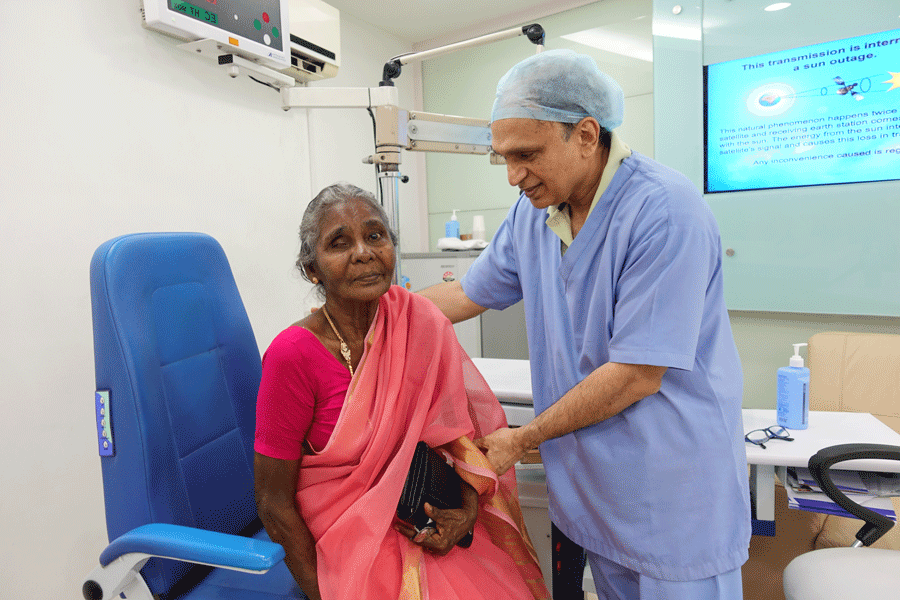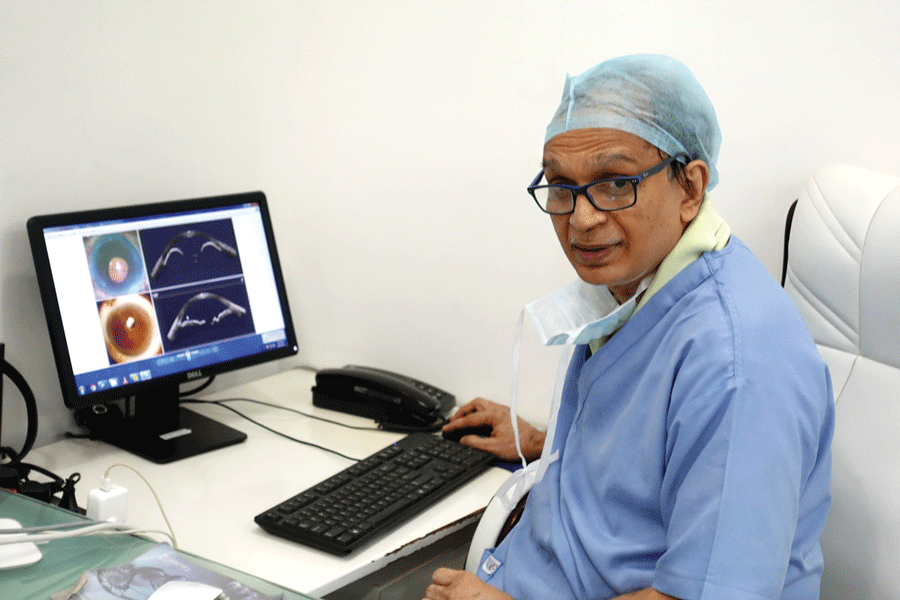Innovate… come to me with crazy ideas
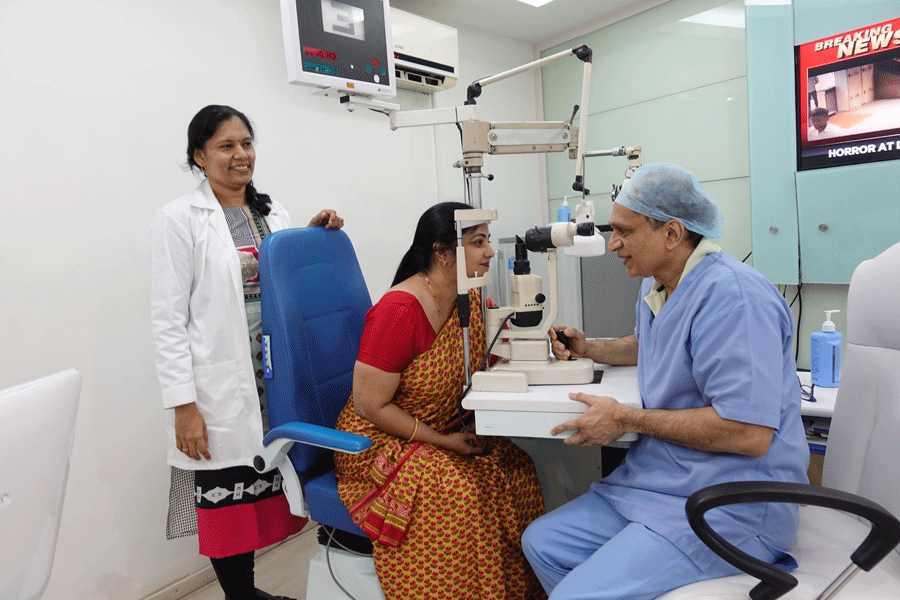
Close your eyes for 10 seconds and you will know how important is the gift of vision,” says noted Ophthalmic Surgeon Dr Amar Agarwal, who hits media headlines regularly for some innovation or the other in eye surgery.
For a moment, his words take me back some 10 to 15 odd years when his father, the late Dr J Agarwal, Chairman of the Dr Agarwal’s group of eye hospitals in Chennai, had told me during an interaction: “Close your eyes for a couple of minutes, you won’t be able to do it, so just imagine the plight of blind people.” His lifelong passion, over a career in ophthalmology spanning 50 years, was to annihilate preventable blindness from India.
The younger Agarwal now heads the Dr Agarwal’s group, which has 75 eye hospitals, 17 in Africa, one coming up in Dubai. “As we speak, a new hospital is opening in Ahmedabad, and by 2020, my vision is to expand to 150 hospitals and have 600 eye surgeons — we now have 350,” he says.
He lives and breathes ophthalmology. You can get a text message at 10 pm and then again at 1 or 2 am; I don’t know when he sleeps!
— Dr S Soundari, Chief Medical Officer
But the nitty gritty of such expansion is done more by his two sons Dr Anosh and Dr Adil, who are trained ophthalmologists but have done management from Harvard and Stanford. Dr Ashar and Dr Ashvin do surgeries, at the Chennai Main Hospital, where he sits. All four sons are eye doctors. I am here to discuss with Dr Amar Agarwal his passion for research and innovation. Over the years, this centre has handled innumerable complicated and complex eye cases that are turned down by other doctors. As a reporter writing on health care for long years, I have covered several press conferences where he announced a new innovation he had carried out in tackling complex eye problems. He never tires of writing books on ophthalmology, and of course articles for medical journals.
So where does he get this scientific bent of mind and the hunger to do innovative techniques in eye surgery, I ask him. Earlier, Dr S Soundari, Chief Medical Officer (CMO) at the Chennai Main Centre, had told me she has lost count of the number of books he writes. “I would say he lives and breathes ophthalmology. You can get a text message at 10 pm and then again at 1 or 2 am; I don’t know when he sleeps!”
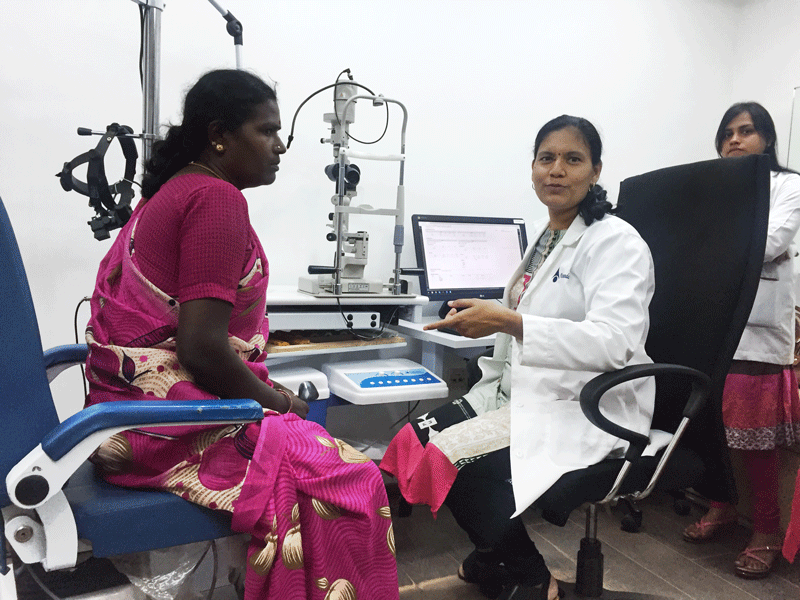
With a glint in his eye, Dr Agarwal answers my question: “Whatever I do or have achieved, is due to divine intervention and has come from the Almighty; no human being has that power. Ideas are human, but you need divine power and help to make them work.” But hard work has of course played a major role. Asked when he sleeps, he smiles and says, “I sleep between 11 pm and 1 or 2 am. Because that is my time to think of new ideas, to write research papers and books. In the day, I am caught up with operations, seeing patients, and other routine matters.”
A pause and he adds, “But one thing I know, I have got the passion for ophthalmology from both papa and mama (his mother was a renowned ophthalmologist too in Chennai). Can you believe it, they came to Madras from Rajasthan 60 years ago with just Rs 60 in their pockets; without passion, and of course dedication and hard work, such an institution cannot be built.”
Killer called glaucoma
Many new ideas and surgical innovations have happened here. When I meet him this time, Dr Agarwal is most excited about having created an easy and replicable surgical technique for closed angle glaucoma. “Unlike in the West, in India we neglect our health and even educated people come for major eye problems to us at an advanced stage.”
Describing glaucoma as a silent killer where vision can be permanently lost if neglected, he explains that there are two kinds of glaucoma (which is caused by elevated intraocular pressure — IOP — which damages the optic nerve), open and closed-angle glaucoma. “We treat open-angle glaucoma by making a drainage because there is too much of fluid coming into the eye; like there is some problem with the meshwork… either too much water or a block in the drainage.”
I sleep between 11 pm and 1 or 2 am. Because that is my time to think of new ideas, to write research papers and books. In the day, I am caught up with operations, seeing patients, and other routine matters.
“But in closed-angle glaucoma, there is not only the drainage problem, the entry to the drainage area is affected. In open-angle the drainage is defective and I repair it by making an opening. But in closed-angle, I am not even able to reach the area where the water is to drain. That is the problem,” says Dr Agarwal.
He has found a simple solution; “now we use a single pass, four-throw pupilloplasty technique — which is basically repairing the pupil. The idea is simple — I make the iris, which is the diaphragm of the eye, taut. When I make it taut, automatically the angle opens and the fluid can nicely drain past.” There are two exciting aspects of this technique; it is so simple that any ophthalmic surgeon anywhere in the world can do it. It doesn’t require great surgical skills, and hence is easily replicable. But even more important, he adds, “through this technique, I am making the anatomy normal, just as we were born, and not creating a drainage passage.”
Dr Agarwal adds that this surgical technique was used in his hospital for the last three years, on patients with an iris defect or had suffered an injury case, or had a problem being born in a consanguineous marriage, “such as a niece marrying an uncle and similar dangerous practices; genetics play a huge role in such defects.”
Easily replicable
So when “we were doing it for three years in such cases, suddenly it struck me why can’t we do the same for glaucoma.” He started, got great results which were published in top medical journals over the last few months. He is thrilled to bits that this simple procedure can be performed by thousands of ophthalmologists, “because glaucoma is a huge blinding problem. Vision lost in glaucoma is permanent; we can cure cataract blindness by removing the cataract and inserting an IOL. But in glaucoma what is lost is lost; as when the IOP goes up, it presses on the nerve of the eye and damages it, resulting in tubular vision.”
What is unforgivable is that people neglect it, he says and gives the example of a woman in her 40s, who has come to him with severe pain and redness of eye. “Hers is a case of sheer neglect. These people do not realise that in youth, the eye can handle anything, but as you grow older, it can’t. She had come to me three years ago and then disappeared, and has now come and I have to operate, there is no other go. She will get immediate relief of course, but when such educated people are so careless about their eye, how do we blame the lower classes?”
Perhaps she was too busy, I say weakly. Raising his voice, the ophthalmologist says, “Nobody is that busy, it is pure neglect. And she is both educated and affluent; it is neglect which is absurd and unforgivable.”
Fine tuning cornea transplant
Dr S Soundari explains the innovations done here on cornea transplant. In earlier times, cornea opacity was being treated by full cornea transplant. “Surgeons replaced the whole cornea when a donor was available, whether the problem was in the front or back; anterior or posterior.” This needed 32 stitches and with the innermost layer — cornea has 15 layers — being “too surgically induced”, during cataract surgery a trauma could result. “So we thought when only the anterior part is involved why change the posterior part of the cornea too, and vice versa.”
The result was a keratoplasty (cornea transplant) which can be either anterior or posterior; which means that one precious donor cornea can be used for two patients and one pair of donor eyes on four patients… something akin to whole blood transfusion and using different components.
At the end of the day, nothing is impossible, but you have to keep motivating and challenging people.
Where the posterior layer or the endothelium, which is very fine — 5–10 microns — is damaged, people started doing Descemet’s Membrane Endothelial Keratoplasty, “but the tissue is so thin that while removing, it tears off and is very difficult to handle. So what we now do is pre-descemets or PDEK technique, which is also taking another adjacent layer which is thicker and doesn’t tear off, and allows easy manoeuvring and the graft can be folded and inserted into the eye. The difference is like the outer and inner covers of a 5 Star chocolate.”
The advantage of the PDEK technique is that this part can be taken even from a very young cornea, and “gives amazing vision to a 60-year-old man,” she says. Not only that, the rigmarole of removing the sutures, etc, is eliminated “and the patient is able to read very quickly. This technique, which Dr Agarwal pioneered three years ago, changes the entire scenario.”
Other innovations
Dr Amar Agarwal is known for a spate of innovations, and “as we talk he is operating on a patient whose cornea is the size of 6 mm — ours is 11 to 12 mm — or what is called micro cornea, where there is non-development of the iris, the retina, etc. Many doctors had given up on this patient. He has done the other eye where the cornea was also 6 mm, and the patient is so happy with the sight he has got, that he wanted the other eye done too,” says Dr Soundari.
Dr Agarwal agrees that many patients given up by others, end up at the main hospital, which is more a referral centre, where many patients come as a last resort. But he is quick to point out that all the ideas are not his; he only encourages them. He recalls that in 2009, when the parents of an agonised four-month-old boy came to the hospital, the doctors were shocked to see that a good portion of the child’s eye was protruding so badly, that he couldn’t close his eye. The surface of the cornea was rough and the child was in immense pain, couldn’t sleep and cried through the night. Only the previous year, he had innovated what is called glued IOL (intraocular lens), for a cataract surgery (See box).
Dr Agarwal explains that a normal eye transplant could not be done, because a large part of the eye was bulging, the deformity being caused by malnutrition or Vitamin A deficiency. The child’s parents were coolies from Vellore in Tamil Nadu. When he showed pictures of the original eye, they were so grotesque that you had to look away. When they were brainstorming on how to help the child, Senior Consultant Dr Soosan Jacob suggested why not he improve on the glued IOL procedure he had innovated the previous year. A new idea was born and successfully implemented.
It wasn’t easy — a four-member team of surgeons performed the surgery which lasted four hours and they restored the child’s eyesight with a modification of the glued lens technology. From the donor eye, the sclera and cornea were carved out, and using this as a bio prosthetic graft, a special lens with an artificially built diaphragm was glued to the sclera; the front portion of the eye was put in place, using tissue glue made from blood products and hence was a bio-glue, and the eye was closed.
Not only did the child’s look improve dramatically, the mother said, “for the first time in four months he has slept in the night. Earlier, he was screaming with pain all the time.”
Vision after 28 years
Later, in 2014, Tamil music director Shankar Ganesh, whose eyes were badly damaged — vision in right eye totally lost and left eye partially damaged — by a mail bomb sent by a ‘fan’, underwent a glued IOL surgery at this hospital and got back his vision after 28 years.
Dr Agarwal hastens to say that “we are not a family business; this is a professional organisation where I give maximum encouragement to new ideas. Anybody who is smart and wants to learn is welcome here.” He wants to make the Agarwal brand a pan-global group touching the 150-hospital mark by 2020. “But the bottleneck is good manpower. It is simple; people come to us because of our brand and want to work with me to learn things such as glued IOL, PDEK procedure etc. I believe there is talent in everybody; if you give them the opportunity they can grow. I tell my doctors, think out-of- the-box, come to me with crazy ideas and let’s try them out. Because, at the end of the day, nothing is impossible, but you have to keep motivating and challenging people.”
Like when thanks to his efforts, Mozambique which has a policy of no transplants at all, is now allowing cornea transplant. “We have changed the law for eye transplant there by showing the government how people can be helped. In Mozambique now, PDEK happens too,” he smiles.
Watching him handle elderly patients, with affection and patience, reminds me of his father, Dr J Agarwal, whose smile was sufficient to take away half of the patient’s fear and pain.
Pictures by Rasheeda Bhagat
Glued IOL surgery
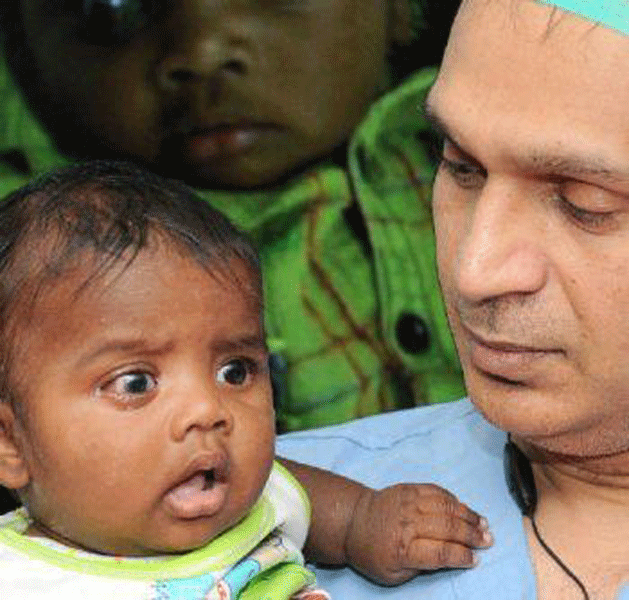
The IOL is placed inside a capsular bag but if this is injured through an injury, a blast or is broken during surgery, the lens has to be sutured to the sclera or the white part of the eye. “But you never know how long the suture strength will last, and over time the suture can give way, or while suturing the lens can tilt or move a little, affecting vision,” explains Dr S Soundari, Chief Medical Officer. In glued IOL, the surgeon creates a small flap on the sclera, sticks or tucks the lens in between with a glue. “Once stuck, the lens moves along with the eye and not separately, and doesn’t shake, which will affect the vision quality. And this can be done on anybody; we’ve done it on a two-month-old baby who had no lens at all, and for old people too. The first case we did was on a 10-year-old who came to us with a cracker injury in 2007, and we are still following up that case,” she adds. In the elderly, this process eliminates what is commonly known as sodabutti (as thick as soda water) glasses. “They can now see without glasses and are extremely happy.”
A rare case Dr Agarwal recalls is that of a three-year-old boy, referred by a Mumbai ophthalmologist, who was born without the iris in both eyes. “There was excess light going into the eyes… it’s like having floodlights focused on your eyes all the time. We needed to reduce that.”
The patient also had a cataract which was removed; as the lens was very badly damaged, “we fixed an IOL with an artificial iris and glued it, so the child had an iris and IOL. Before the surgery he used to sit crouched all the time and shield his eyes with both hands, unable to bear the harsh light. Next day he was walking around the corridor.”

